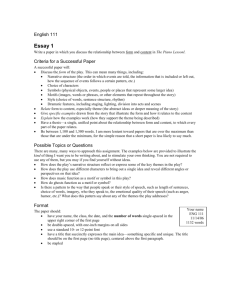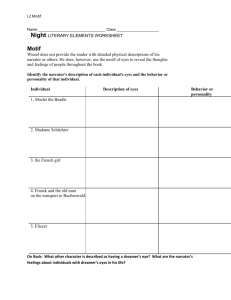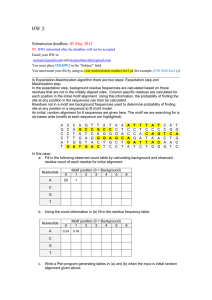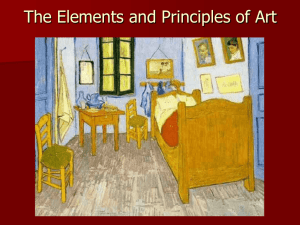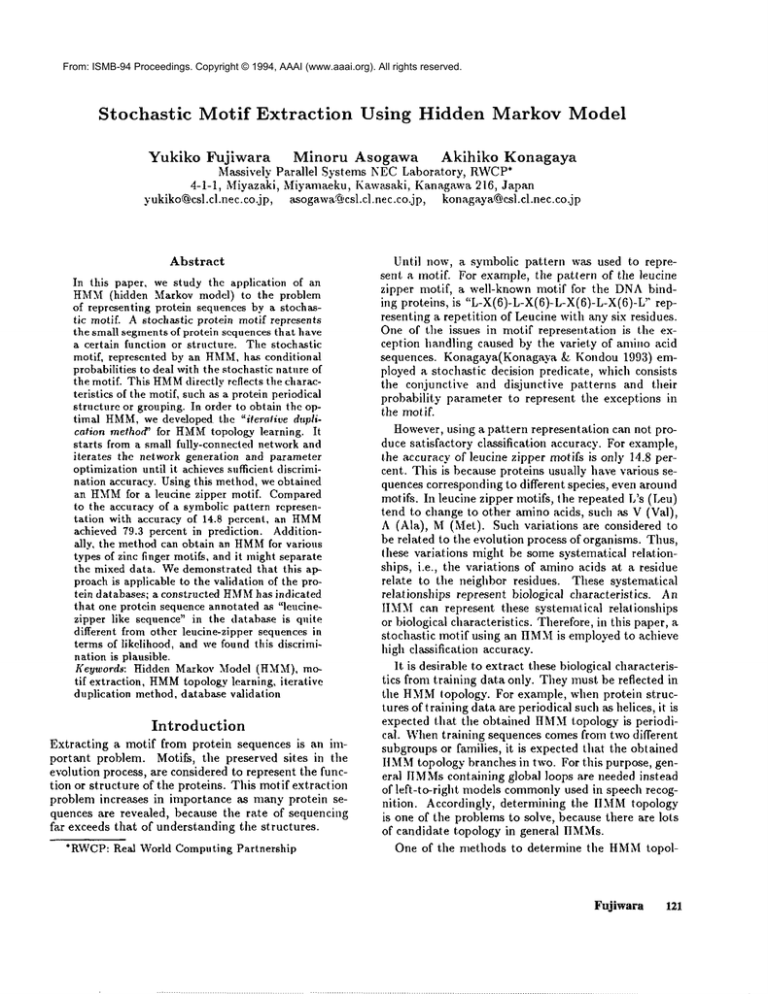
From: ISMB-94 Proceedings. Copyright © 1994, AAAI (www.aaai.org). All rights reserved.
Stochastic
Motif
Extraction
Using Hidden Markov Model
Yukiko
Fujiwara
Minoru
Asogawa
Akihiko
Konagaya
Massively Parallel Systems NECLaboratory, RWCP*
4-1-1, Miyazaki, Miyamaeku, Kawasaki, Kanagawa 216, Japan
yukiko@csl.cl.nec.co.jp,
asogawa@csl.cl.nec.co.jp, konagaya@csl.cl.nec.co.jp
Abstract
In this paper, we study the application of an
ttMM (hidden Markov model) to the problem
of representing protein sequences by a stochastic motif. A stochastic protein motif represents
the small segmentsof protein sequencesthat have
a certain function or structure. The stochastic
motif, represented by an HMM,
has conditional
probabilities to deal with the stochastic nature of
the motif. This HMM
directly reflects the characteristics of the motif, such as a protein periodical
structure or grouping. In order to obtain the optimal HMM,
we developed, the "iterative duplication method’ for HMM
topology learning. It
starts from a small fully-connected network and
iterates the network generation and parameter
optimizationuntil it achievessufficient discrimination accuracy. Using this method, we obtained
an ttMMfor a leucine zipper motif. Compared
to the accuracy of a symbolic pattern representation with accuracy of 14.8 percent, an tIMM
achieved 79.3 percent in prediction. Additionally, the methodcan obtain an HMM
for various
types of zinc finger motifs, and it mightseparate
the mixed data. Wedemonstrated that this approachis applicable to the validation of the protein databases; a constructed HMM
has indicated
that one protein sequence annotated as "leucinezipper like sequence" in the database is quite
different from other leucine-zipper sequencesin
terms of likelihood, and we found this discrimination is plausible.
Keyn, ords: Hidden Markov Model (HMM),motif extraction, HMM
topology learning, iterative
duplication method, database validation
Introduction
Extracting a motif from protein sequences is an important problem. Motifs, the preserved sites in the
evolution process, are considered to represent the function or structure of the proteins. This motif extraction
problem increases in importance as many protein sequences are revealed, because the rate of sequencing
far exceeds that of understanding the structures.
*RWCP:Real World Computing Partnership
Until now, a symbolic pattern was used to represent a motif. For example, the pattern of the ieucine
zipper motif, a well-known motif for the DNAbinding proteins, is "L-X(6)-L-X(6)-L-X(6)-L-X(6)-L"
resenting a repetition of Leucine with any six residues.
One of the issues in motif representation is the exception handling caused by the variety of anfino acid
sequences. Konagaya(Konagaya &. Kondou 1993) employed a stochastic decision predicate, which consists
the conjunctive and disjunctive patterns and their
probability parameter to represent the exceptions in
the motif.
However,using a pattern representation can not produce satisfactory classification accuracy. For example,
the accuracy of leucine zipper motifs is only 14.8 percent. This is because proteins usually have various sequences corresponding to different species, even around
motifs. In leucine zipper motifs, the repeated b’s (Leu)
tend to change to other amino acids, such as V (Val),
A (Ala), M (Met). Such variations are considered
be related to the evolution process of organisms. Tlms,
these variations might be some systematical relationships, i.e., the variations of aminoacids at. a residue
relate to the neighbor residues. These systematical
relationships represent biological characteristics. An
IIMMcan represent these systematical relationships
or biological characteristics. Therefore, in this paper, a
stochastic motif using an HMM
is employed to achieve
high classification accuracy.
It is desirable to extract these biological characteristics from training data only. They must be reflected in
the HMM
Iopology. For example, when protein structures of t raining data are periodical such as helices, it is
expected that the obtained HMM
topology is periodical. Whentraining sequences comes from two different
subgroups or families, it is expected that the obtained
ItMMtopology branches in two. For this purpose, general IIMMscontaining global loops are needed instead
of left-to-right models commonlyused in speech recognition. Accordingly, determining the IIMMtopology
is one of the problems to solve, because there are lots
of candidate topology in general IIMMs.
One of the methods to determine the HMM
topoi-
Fujiwara
121
ProteinDataBase
I
1
Belonging
to CertainCategory
[
-.,¢e-----~lterativeDuplication
Method
Learning
I
Unknown
Sequences
Motif
Reprcsented by HMM I
Predicti°’~n
I Target
Categ°ry
IorNot
Figure 1: Outline of motif extraction
ogy is to train from a large fully-connected IIMMand
delete negligible transitions.
However, the HMM
resulting from a fidly-connected one may be very complex and difficult, to interpret. Moreover,it. takes quite
a bit training time in order to optimize numerous free
parameters.
Thus, a new method, "the iteralive
duplication
methotF, is developed for IIMMlearning(Fujiwara &:
Konagaya 1993). The method enables us to obtain
an optimal IIMMtopology for the given training sequences, as well ,as optimal IIMMparameters for the
network. It starts from a sm~dl fully-connected network and iterates the network generation and parameter optimization. The network generation prunes transitions and adds a state according to tile previous
topology. This method obtains simpler IIMMtopology in less time than the one obtained from a fullyconnected model. As a result of this method, for example, the accuracy of leuciue zipper motifs is 79.3
percent. It is high when compared with accuracy of
i’1.8 percent when using the symbolic representation.
Figure 1 showsthe outline of this motif extraction.
The validation of protein databases using IIMMsis
also discussed. One of the It MMswe have constructed
has indicated that a protein sequence annotated as
"leucine-zipper like" in the database is quite different
from other leucine zipper sequences in terms of likelihood, and we found this annotation is questionable.
Additionally, our method also revealed that some sequences without motif annotations shouht be discriminated as leucine zipper motifs.
This paper is organized as followitlgs. First, we explain IIMMs and related works on I-IMMs. q’hen, we
explain the :’iterutive duplication methotF for IIMM
learning and the predicting method. After that, we
give the experimental results of two motif extraclions
and discuss examples of validating the database. Finally, we discuss the ite-ratwe duplication method in
more detail.
122
ISMB-94
HMMs
Overview
An HMM
is a nondeterlninistic finite state automaton
that represents a Maxkov process. IIMMs are commonly used in speech recognition(Nakagawa 1988), and
recently have been applied to protein structure grammar estimation(Asai, Itayamizu, & Onizuka 1993) and
protein modeling(Haussler ef al. 1993), (Baldi et al.
1994).
An IIMMis characterized by a network with a finite number of parameters and slates (see Figure 2).
Parameters represent initial probabilities, transition
probabilities, and observation probabilities. At discrete instants of time, the process is assumedto be in
one state and an observation (or output symbol) is generated by the observation probability corresponding to
the current state. This state then changes depending
upon its transition probability.
Tran.prob.
I
Init. prob.=1.0
ON.prob.
hilt. prob.=O.O
Figure 2: An example of HMM
(lefl,-to-right)
A special type of IIMM,called a left-to-right model
it1 Figure 2, is commonlyused in the case of speech
recognition. In this model, states are linearly connected with self-loop transitions; a state visited once
is never revisited at a later time. This is because there
is little requirement to de~l with periodic structures in
speech recognition. IIowever, such periodic structures
are rat]mr commott in amino acid sequences and have
great significance for constructing a geometric slructure. Therefore, we adopt a general IIMMcontaining
global loops.
The correspondence between motifs and HMMsis
the following. The training set is the portions of amino
acid sequences that have the same structure or function. An IIMMis expected to model the training proreins in terms of discrimination. The alphabet used
for the output symbols corresponds to 20 amino acids.
The test sequence is the portion of an amino acid sequence which might have the target st ructure or function. The result is the likelihood of the test sequence
calculated by I racing all possible I ransit ion paths that
observe the lest sequence in the IIMM.
To use a trained IIMMas a classifier, we first define
a Ihreshohl value according to the probabilities generating positive examples. The probability generated
by a given sequence is compared against the threshold
Table 1: Zinc Finger in Prosit.e R25
II posI "egl
Type
C2H2
836
48
C4
315 8471
C3lt
33
152
C3tIC4
0
30
G ATA
0
30
C8C5C3H
8
5
PA RP
8
0
Others
65
TotaI 1{ 1327 18676 I
Consensus patterns in Prosite
C-x(2,4)-C-x(12)-H-x(3,5)-H
C-x(2,7)-C-x(0,~s)-C-x(1,4)-c
C-x(2)-C-x(d)-II-x(4)-C
or C-x(2)-C-x(12,13)-If-x(4)-C
C-x(2)-C-x(O,d2)-C-x-tI-x-[LIVM FYJ-C-x(2)-C-[LIVMA-C-x(0,d2)-C-x(2)-C
C-x-’N-C-x(4)-T-x-L-W- R- R-x(3)-G-x(3)-C-N-A-C
C-x(S)-C-x(5)-C-x(3)-tt
c K-x-C-x-[QE]-x(3)K-x(3)- R-x(16,18)-W-[H
Y]-H-x(2)-C
value, and the sequences producing larger values are
classified as the motif. One of the great advantages of
using HMMs
is that we can quantify similarity between
the test sequence and the training set by comparing
their likelihood on the HMM.
Related
Works
Haussler et.all(Haussler
et al. 1993) use HMMs
for stochastical modeling and multiple alignment of
globins. Baldi et.al.(Baldi el al. 1994), (Baldi & Chauvin 1994) use IIMMsfor globins, immunoglobins and
kinases. Since they chose one of the left-to-right model,
they cannot treat global loops except self-loops. Asai
et.all(Asai,
Hayamizu, & Onizuka 1993) use HMMs
for secondary structure prediction. They propose a
method to construct a large HMM
from smaller HMMs
using a protein structure
grammar. However, the
grammar depends on human knowledge at the current stage. As for automatic learning of HMM
network topology, Takanfi(Takami & Sagayama 1991) proposes a state splitting method for speech recognition.
It starts from a small IIMMand increases the number
of states by choosing better state splitting; although
the modelis restricted to left-to-right models. Our approach is more general and can deal with any network
topology.
Motif
Extraction
using
Additionally, a zinc finger motif, describing a nucleic
acid-binding protein structure, was also extracted with
our method. There are 1327 subsequences annotated
as zinc fingers in the Swiss Protein database Release
25. The training data were chosen to be 90 percent of
these positive data. The test data is the rest of the
positive data and the 8676 negative data containing
the motif pattern (See Table 1).
Learning
Algorithm
input: (protein) sequences and
a small fully-connected tlMM.
initialization:
opthnize parameter for the HMM.
choose the best HMM
on likelihood
as a seed.
repeat
network generation:
delete negligible transitions.
copy the most connected state.
parameter optimization:
optimize parameters for the new topology.
choose the best IIMMon likelihood.
until sufficient accuracy is obtained.
output: the resulting IIMM.
HMM
Training
Data and Test Data
For the purpose of extracting a leucine zipper motif,
112 positive examples, which are the collection of subsequences annotated as leucine zipper (like), were chosen from the Swiss Protein database Release 22. Also,
112 negative examples were randomly selected, which
satisfy the Prosite (motif database) pattern "L-X(6)L-X(6)-L-X(6)-L-X(6)-L", a repetition of leucine
any six residues(Aitken 1990). Naturally, those negative examplesare similar to positive examplesin terms
of symbolic representation. Randomlyselected, 80 percent of the positive subsequences are used for training,
and the remaining positive and all negative examples
are used for prediction performance evaluation.
Figure 3: Iterative
Duplication Method
In order to obtain the optimal IIMMtopology for
the given training sequences, as1 "iterative duplication
melhod(Fujiwara & Konagaya 1993)" is used. This
method also produces the optimal [IMMparameters
for the network. The method includes transition network generation and parameter optimization.
The
method is summarized in Figure 3. It starts from a
small fully-connected network. In order to avoid converging in the local maximum, many initial
IIMMs
with random parameters are prepared. The BaumWelch algorithm is used for parameter optimization.
Network generation is performed by copying one node
Fujiwara
123
~ttt~t"~~
~" [;.0.22
E0.26
Q0.19
"~
V0.18
K0.16
Q0.1S
EO.20
S00112
A0.18
I
IOll65
r
(a)
L0~~
,~
o.94
,-,
~:.1110
0.50
v o.~;-~
1.00
(b)
1.00
1.00
(c)
Qfl~l
I~O, lO
"~
E0.13
f_.
SO.I,
1J)o~e~l00
K0.11
"~
E0.33
R0.13
10.1_2
K0.12
N0.12
L0.1I
A 0.16
Figure 4: A step of learning. (Left) A general rule
for a duplication. (R.ight)
An example of the step from
six to seven. (a) The resuiting ]IMMwith 6 states
after parameter optimization
and negligible transition deletion. (b) A new network
a hatched state copy. (c)
obtained HMM
with 7 states
after parameter optituization
and negligible transition deletion.
Q 0.10
selected from tile current network. The method iterates the network generation and parameter optirnizaLion phases until sufficient discrimination accuracy is
obtained.
The details of network generation follow. First, we
delete the transitions with negligible transitional probability, that is less than t = max(t1, r), where ea is
smoothing value and r is a convergence radius. Next,
for each state S~ except the final state, we count the
number of incoming and outgoing transitions of the
state, that is the numberof transitions from the state
~ plus that of transitions to the state Si. Then we
select the state with the largest number (denoted as
S~) and make a copy of it (denoted as Sn,,o) so that
S,,~.,, hasthe same transition with S,. If the state S~
has a self-loop, S,~,,o has a self-loop and the transitions
from S, to S,~e,o and from ~S~,~, to S~ (see Figure 4).
Tlle purpose of deleting the negligible trmlsitions is
to restrict, the network topology space and eventually
to reduce the training cost for parameter optimization.
The reason to split the most connected node is that it
miglat represent overlapping of independent states. In
this case, the network topology may become simpler
by splitting Ihe states.
Figure ,1 showsan exampleof such a case1. 111 Figure
4 (a), the most connected state is a hatched state which
outputs E (Glu) with probability 0.26, Q (Gin)
probability 0.15 and so o11. By splitting the state into
two states, we will obtain a new network which has
1Thetransitions unrelated to our explanation are omitted in Figure 4.
124
ISMB-94
additional transitions represented by bold lines (see
Figure 4 (b)). However, the network can be become
simpler, if the most transitions becomenegligible after
parameter optimization (see Figure 4 (c)).
hi each step, this algorithm products an optimal
IIMMfor the training data with each numberof states.
Selecting the IIMMwith highest prediction accuracy,
we oblain the optimal number of states for the given
data.
Predicting
Method
Prediction is performed by comparing likelihood, that
is the probability of generating a given sequence and
a threshold value obtained from training data. If a
sequence achieves higher likelihood than the threshold
value, then it is predicted to have the target mot if, that
is, the same structure and/or function.
111 the current implementation, the threshold value
is represented by the worst observed probability in the
training set will, the same length as a given sequence.
Such threshold dependency to lengtl, is regarded as
based on the fact that longer sequences tend to have
worse observation probabilities. Morecareful study is
needed to discuss more meaningful thresholds. One
solution would be to use discrimination analysis with
data of various lengths (see Figure 5). This discriulinaLion analysis is used for the zinc finger motif analysis.
The total prediction performance is measured by the
following equation,
(accuracy)=l.O-~
i (z+ Z-
x N+ +~),
Loga.rithm likelihood
(Bit
I
§
Discriminate
as Motif
Discriminant
Analysis Line
8
x x
X
:
o Positive
× Negative
/
-X
×
/
Accuracy
(%)
95
neg.dam/\/’~q
,,-- ,../ ’4
85
total ,,
80
75
~ ¯
[
t-
~
Discriminate
Non-Motif
as ~
70
65
,~ /
oos.data
t
k
The number of sequences
Figure 5: Discrimination Analysis
10
where N+ is the number of positive examples, N- is
the number of negative examples and E+ is the number
of errors occurred in the positive examples, that is,
the number of the positive data categorizing as the
negative by the IIMM. E- is the number of negative
errors.
Evaluation
Experimental
Results
Table 2 shows the result of cross-validation for leucine
zipper motifs. Positive data is divided into 5 groups
and tested with both negative and positive data. Tile
average prediction accuracy is 99.1 percent for training data and 79.3 percent for test. data; 81.3 percent for
positive data and 77.3 percent, for negative data. Note
that in case of the symbolic motif representation as in
Prosite, the average prediction accuracy for test data
is just. 14.8 percent; 29.5 percent for the positive data
and 0.0 percent for the negative data. The low prediction performance of symbolic representation mainly
results from the biasing in the negative test set which
is chosen from the sequences sinfilar to the positive set.
It is apparent tlMMsare more powerful than symbolic
representation in terms of prediction performance.
Table 2: Prediction accuracy (leucine zipper)
pos.dataI II pos.data
II
testO
98.9%
81.8%
testl
test2
test3
test4
Ave.
I
100.0%
98.9%
98.9%
98.9%
II
99.1%
91.3’%
68.2%
87.0%
77.3%
neg.data
average
83.0% 82.4%
65.2%
78.2oW
83.9%
76.1%
78.6%
82.8%
75.9%
76.6%
II 81-3%1 77.3%
79.3%
20
30
The numberof states
Figure 6: Prediction performance (leucine zipper)
Hydrophilic " Hydrophobic
LeucineZipper,~’~"q,
Motif
~
z__.
"lt~-~7-~
Ovscrved
from
above
,,~’.,,
x/~_,t
Helix
~
~ ~}.~::~
1
L
Hydrop.hobic
I
Basic
’~~
DNA-bindingsite
Q-.
5 2
Hydmphilic
Figure 7: (Left) Biological structure of a leucine zipper
motif. (Right)The helical wheel.
Figure 6 shows the test. data prediction performance
with respect to the number of states for the leucine
zipper motifs. It shows that as the number of states
increases, the prediction performance for negative data
increases, but for positive data, it decreases. This is
natural since the expressive power of HMMs
increases
as the numberof states, and may over-fit the training
data. Criterion such as the MDLprinciple may be
helpful for avoiding the over-fitting but further study is
required. In the current implementation, HMMswith
twelve states are chosen, because we regard positive
accuracy to be more important than negative.
Figure 8 shows an IIMMfor leucine zipper motifs
obtained using the ilerative dnplication method. This
HMM
contains global loops corresponding to the "helical structure" in the leucine zipper motif. Such helical
Fujiwara
123
Figure
8: (Left)
An HMM
(leucine zipper). (Right)
helical wheel, i,e. , helices ob.served from the head at HMM
paths, llydrophobic, hydrophilic
and t.he other aminoacids are described by bold, pale and broken
letters, respectively. The characters on tile circles are the most
frequently observed amino acids
at each state.
L0.89
LogarithmLikelihood
(Bit)
CPUtime
x t03ms.
70.~
60.0{3
50.0~
40.~
9OO0
Training by
a fully-connected
8500
30.013
20.0(3
10.0E
0.0~
Iterative Duplication
_
Method
t0
15
20Thenumber
of states
Figure 9: Learning time (leucine zipper)
structure shownin the figure 7 is caused by the existence of seven amino acids per each two periods. This
is because a pair of aligned leucines forms a zipperlike structure. On the sight of Figure 7, this characteristic can be seen in the circles, the helices viewed
from above. These circles show that there are many
hydrophobic amino acids on one side around combined leucines and many hydrophilie amino acids on
the other side. This tendency of hydrophilic and hydrophobic amino acids is one of the characteristics of
the helices, and is called a helical wheel. As compared
with lhis, in the figure 8, each circle at the right corresponding to each IIMMpass h~s a similar characteristic to helical wheel. The characters on the circles
are the most frequently observed amino acid in each
state. In order to see the helical wheel, hydrophobic
126
ISMB--94
80O0
5
I
I "~,,.-,,,,
lterative Duplication’~
I MethodI
10
15
20The numberof states
Figure 10: Likelihood (leucine zipper)
aminoacids, such as l (lie), V (Val), L (Leu), F
C (Cys) are described by bold letters in the following.
On the other hand, hydrophilic amino acids, such as R
(Arg), K (Lys), N (Asn), D (Asp), Q (Gin),
(Ilk) are described by pale letters. Another M(Met),
A (Ala), G (Gly), T (Thr), S (Ser), W(Trp),
P (Pro) are described by broken letters. These circles
showthree kinds of helical wheels. Therefore, the iteralive duplication method automatically extracted the
helical structures and characteristics from the positive
data.
A similar result can be obtained when using a large
fully-connected IIMM.llowever, it. takes muchlonger
time t.han our method (see Figure 9, 10).
Table 3 showsthe result of cross-validation for zinc
finger motifs. Positive data is divided into 10 groups
C2H2 type
Cl.O
E0.4 C0.9 G0~^K0.6
Aa F0.9 $0.3
u.~
"-’:(:>____~ ~,
¯
0.6
0.1~
/],. 0.1
"’¯ x~0.1
o.1
L0.9
H1.0 Q0.3
:~_~ :~.__~
:~)___~ R0.5
l
0.9[ H 0.6
$0.5
~~
:~
x 0.6
J. co.2
C4 type
C0.8
C 1.0
fi7
~
Y0"4G0"3
N~ N~
o,
I,
/
/
N’~ C0’7
~
]
\
I
......
\
C0.9 RO.9 L0.5K0.4
0.7
Figure 12: An ItMM(zinc finger)
Table 3: Prediction accuracy (zinc finger)
I
test0
testl
test2
test3
test4
test5
test.8
test7
test8
tesi,9
yAve.
I trainin$
[ pos.data
93_4%
93.7%
93.1%
92.3%
92.6%
91:5~
93.8%
93.1%
92.3%
94.1%
I[
test
pos.data I neg.data I average
83.2%
87.8%
85.5%
88.1%
95.5%
80.8%
90.2%
78.1%
84.2%
93.3%
80.9%
87.1%
88.8%
77.5%
83.2%
83.6%
80.1%
81.8%
91.8%
81.9%
86.8%
89.4%
81.9%
85.6%
84.2%
85.3%
91.,6% 84.2% 87.9%
93.o%II 89.4% ’81.7% 85.6%
Accuracy (%)
100
Training
90
t~est:Pos.
80
f
[’e.st:Neg.
70
60
5C
and tested with both negative and positive data¯ Figure 11 shows the prediction performaace with respect
to the numberof states for the zinc finger motifs. The
average prediction accuracy is 93.0 percent for training data and 85.6 percent for test data; 89.4 percent
for positive data and 81.7 percent for negative data.
Using the symbolic representation described in Table
1, the accuracy is 47.5 percent (95¯0 percent for positive data and 0.0 percent for negative data). These
leucine zipper and zinc finger motifs are represented
by ambiguous symbolic patterns, i.e., they are weak
motifs.
Figure 12 is aa HMM
for a zinc finger motif. The
biological structure of the zinc finger is shownin figure
13. Mixed data, e.g., C2H2and C4 type, are used for
training; however these mixed data might be separated
v
10
20
30
40
Thenumberof states
50
Figure 11: Prediction performance (zinc finger)
into several passes on the basis of their types by our
method.
The Prosite gives more details, i.e., "generally, but
not always, the residue in position +4 after the second
cysteine is an aromatic residue, and that in position
+10 is a leuciue" in case of C2It2 type. Our method
reveals these tendencies. Moreover,it. reveals the tendencies in the other position (See in Figure 12).
Validation
of Database
Since the IIMMgives a quaatitative value with respect to the similarity of a sequence to the traitfing
Fujiwara
127
C4 type
C2H2 type
,xxx 1
X
X
X
xXC\zn/C
X
X
X
xx
ATF6 HUMAN
V
N
MYC_AVIMC
L
~
C...Zn.-. ~ ~.~,.
x c/ x,,c
x xx
KU7_HUMAN
L
/ It\.
xx x
,-
I..,,c.,k:~
Figure 13: Biological structure (zinc finger)
Figure 15: Art example of database Validat.ion
sequences, it is also applicable for the database validation. For example, in case of a leucine zipper motif,
the likelihood of positive and negative examples with
length 29 is shown in Figure 14. As shown iu the figure, one data (KU7_IIUMAN)
which has an annotation
"leueine zipper moliflike" is far from the other positive
exantples. Therefore, tiffs annotal ion of KU7_I1UMAN
is questionable. According t.o the original paper mentioning KU7_IIUMAN,
the authors stated Ihat they
are not fully confident KU7_HUMAN
is the leucine zipper motif. Note that KU7_I]UMAN
is included in the
training data.
Motif
Po~iblity High-4-
-~. Low
Positive ~,~,,~ ~.~.~ ................
~ .............
Data
~ ......
KU7_ ff3MAN
~,-.....
~~’,~
$~,,~
Negative ~.~.-&.,~.-’,.,~
,~,,~ ,~-,,.,.,,-,,.,~
~:’~<~,~,~.’:’:’~
~<’,g~:¢
Data
~.,~<’~
..............
.~ ~, M5S’I RPY
MOU
~x.~,,~.N~
~,~,,,,~,,N~
~,~.N\,’~.,.
~"~
-~.,~,-
MYC ~VlM(
~ ~
~g~,
~
~
"’’MYS~ ~ICDI
RGI2
~,,s,~,~,~.~,"’""""
.....
~,N\",%\’~,\’~"\""\\’~""~
~,~""’~’~"\’~
’""~~-~,-~-,~,\-.~\~"’~"’~""""
0.00
-10.00 -20.00
Thresholdvalue
_~ACTI.
-40.00 -50.00
LogarithmLikelihood (Bit)
Figure 14: Each likelihood (leucine zipper)
At, the same time, the IIMM reveals that MYC_
AVIMChas a subsequence that achieves high likelihood, tlowever,
it has no annotation.
MYCs
in other species,
MYC_FELCA, MYC_IIUMAN,
MYC_MOUSE
have annotations about "leucine zipper
motif". There are five such data with no annotations
for motifs. These indistinct data were also not omitted
in calculating accuracy.
The questionable cases are shown in Figure 15. The
circles show helices observed from above. Data are described from the inside out. ATF6_IIUMA
N is one of
128
ISMB-94
the positive data. Compared to this, KUT_HUMAN
breaks the helical wheel with respect to the distribution tendency of hydrophilic and hydrophobic anaino
acids. MYC_AVIMC
not annotated motif has a typical leucine zipper motif, aligned leucines and ll~e helical
wheel.
These results show that IIMMshave good potential
for the database validation.
Discussion
In order to represent a motif, an HMM
has some
advantages over a symbolic pat.tern. It deals with the
stochastic nature of the motif. For example, a leucine
zipper motif forms a helical structure, a helix, characterized "helical wheel" that tends to partition hydrophilic and hydrophobie residues. This tendency
is difficult to represent accurately by a symbolic pattern, so the symbolic pattern "L-X(6)-L-X(6)-L-X(6)I,-X(6)-I," is far from being a specific pattern. On
the other hand, the IIMMrepresents the tendency,
enabling us to obtain high accuracy in prediction.
Moreover, the IIMMrepresents the relationship anaong
aminoacids. For example, figure 8 in the previous section showsthat if G (Gly)is next to L (Leu), the anaino
acid next to G tends to be A (Ala), Q (Glu) or K (Lys).
The iteralive duplication method seems to produce
the optimal IIMMtopology using only training data.
This method gradually grows the IIMMtopology containing global loops.
The method initially chooses a smM1I:IMMtopology
for training data after parameter optintization and negligible transition deletion. In this topology, each state
might conlain the union of independent characteristics,
e.g., output probabilities and state connections, since
the nun~berof st ates is insufficient.
Then, the method tries to find an overlapping state
for dividing its characteristics.
The most connected
state is selected for division, because this state has
maa~ytransitions from or to various states. In the current implementation, we randomly select, one of the
most connected states. Someselection criteria maybe
studied in the future.
Vertical growth
= Parameter
Optimization
:~:
Horizontal growth
or
~
~.
Right-to-left
or
or~
~.
Skipping
~
~
~,
Figure 16: IIMMtopology growth
Copying a state might grow tile IIMMtopology.
This is clear after parameter optimization at the next
step (see Figure 16). Whentwo branches are needed
at the state, the IIMMgrows in the vertical direction.
On the other hand, when it is necessary to lengthen
at a state, it grows in the horizontal direction. Moreover, it grows more complex structure, such as rightto-left transitions, or skipping transitions over states,
if needed.
In each step, trained parameters might be used as
the next initial parameters. However, these parameters tend to lead a local optimal topology, because the
Baum-Welchalgorithm converges to tile local maximumlikelihood. Moreover, tiffs iterative method expands the error. Therefore, random initial parameters
are used in our method. Stochastic search algorithm
such as a genetic algorithm, would be applicable in
stead of random search.
Conclusion
An IIMMis capable of representing a stochastic motif well. According to the experience of leucine zipper
motif extraction, the IIMMshows higher discrimination performance than symbolic motif representation.
The HMM
is also useful for the validation of annotated comments in amino acid sequence database. In
fact, one ambiguous entry was detected by the generated IIMM. Additionally, some data is found that
they omit annotations of leucine zipper motifs. As
for the learning performance, the iterative duplication
method, increasing the number of states step by step,
produces the optimal HMMcontaining global loops
from the training data only. It greatly reduces convergence speed compared to Baum-Welch algorithm for
fully connected IIMMs.
Acknowledgements --The authors would like to thank
Dr. Shimaxta, the director of Real World Computing
Partnership, Dr. Yamamoto,the director of C&CResearch Laboratories, NECCorporation, Dr. Koike, tlm
,senior manager of Computer System Laboratory, NEC
Corporation and Mr. Kajihara, the assistant manager
of massively parallel systems NEClaboratory.
References
Aitken, A. 1990. Identification of Protein Consensus
Sequences. Ellis HorwoodLimited.
Asai, K.; IIayamizu, S.; rind Onizuka, K. 1993.
hmmwith protein structure grammar. Proceedings
of the Twenty.sizth IIa.waii International Conference
on System Science I:pp783-791.
Baldi, P., and Chauvin, Y. 1994. smooth on-line
learning algorithms for hidden markov models. Neural
Computation 6(2):pp307-318.
Baldi, P.; Chauvin, Y.; IIunkapiller, T.; and McClure,
M. A. 1994. hidden markov models of biological primary sequence information. Proceedings of the National Academyof Sciences of the USA91(3):ppl0591063.
Fujiwara, Y., and Konagaya, A. 1993. protein motif
extraction using hidden markov model. In Proceedings
of GenomeInformatics Workshop IV, pp56-64.
IIaussler, D.; Krogh, A.; Mian, I.; and Sjolander, K.
1993. protein modeling using hidden markov models:
analysis of globins. Proceedings of the Twenty-sizth
Hawaii Inter’national Conference on System Science
I:pp792-802.
Konagaya, A., and Kondou, I1. 1993. stochastic motif extraction using a genetic algorithm with the mdl
principle. Proceedingsof the Twenty-si~’th IIawaii International Conference on System Science I:pp746753.
Nakagawa, S. 1988. Speech Recognition
Us,ng
Stochastic Models. Electronic Society of Information
Communication.
Takami, J., and Sagayama, S. 1991. automatic generation of the hidden marcov network by successive
state splitting. In Proceedings of ICASSP.
Fujiwara
129



